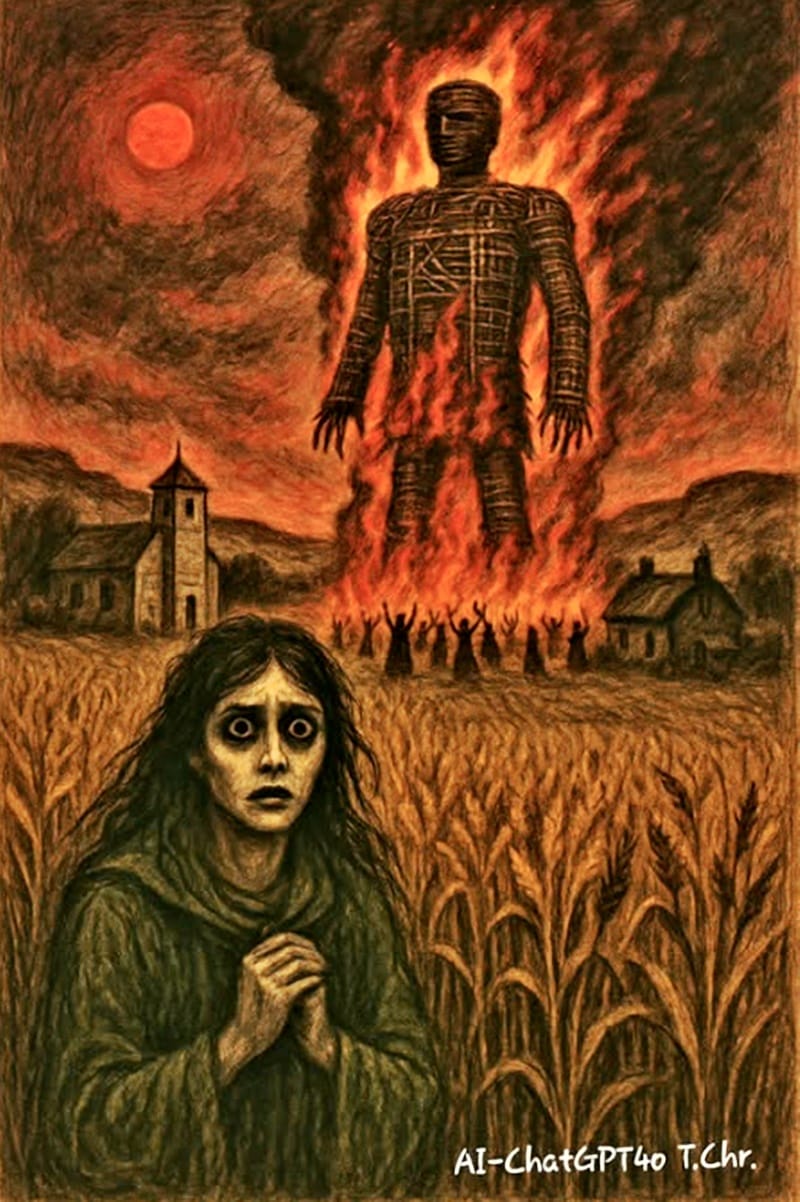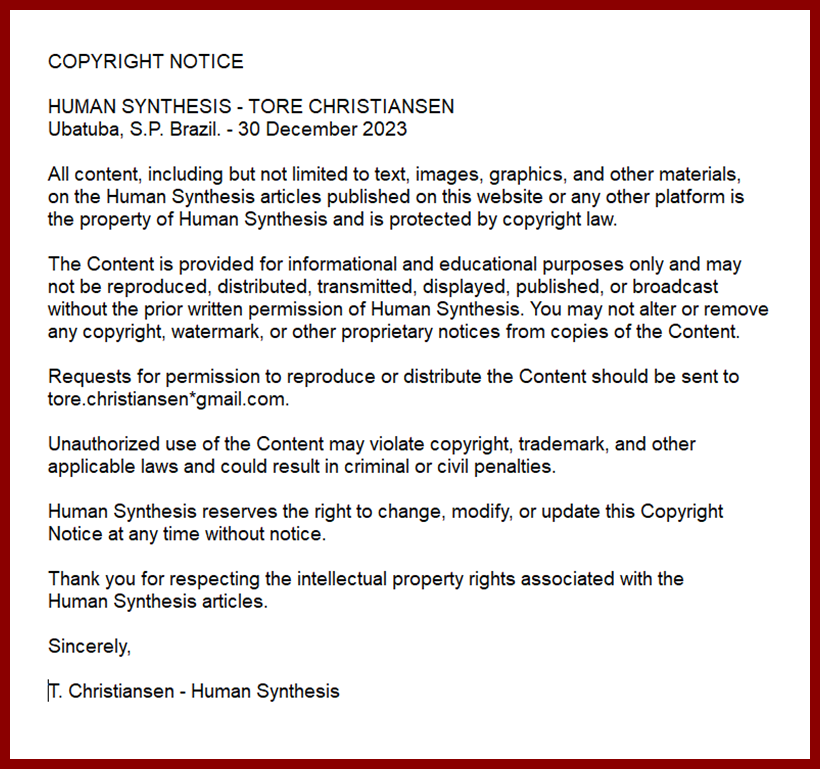"THE HARVEST OF HOLLOW GLEN"

By AI-ChatGPT4o-T.Chr.-Human Synthesis-20 April 2025
An original folk-horror story.
Detective Clara Morven, a pragmatic and skeptical investigator from the city, receives an anonymous letter: "A child is missing. Come alone. Do not trust the locals." The letter is unsigned but postmarked from Hollow Glen, a secluded farming valley nestled deep in the Yorkshire moors—one long-forgotten on modern maps.
Upon arrival, Clara is met with bucolic beauty: golden fields of barley swaying in the wind, locals dressed in timeless clothing, and laughter that echoes from unseen corners. The people are warm, welcoming, and curiously evasive. They deny any child is missing. "No one named Elsie ever lived here," they smile.
Clara stays in the village inn, where each room bears the name of a plant—she is given Foxglove. That night, she is kept awake by a rhythmic chanting in the distance and catches glimpses of robed figures moving through the barley under the moonlight.
As she investigates, Clara learns of a harvest festival called The Renewal, held every 33 years to ensure the valley’s unending bounty. The people speak of the Earth as a mother who demands balance, of a "Seed Child" chosen in secret. She finds drawings in a barn—spirals, suns, and stick figures engulfed in flames.
Tensions rise when she discovers a photograph hidden behind the altar in the chapel—of a young girl in modern clothing, eyes wide with fear, standing before a towering effigy made of woven twigs and barley stalks. The girl wears a necklace shaped like a fox. Clara had seen that same necklace on a roadside shrine outside the village.
The villagers’ masks begin to fall. They start to call her The Skeptic, whispering that the Earth always takes what She is owed. Clara tries to leave, but the road back has vanished into mist. Her car is gone. Her phone shows only static. Her dreams bleed into reality.
On the night of The Renewal, Clara is drugged and dressed in ceremonial robes. She awakens inside the Barley Man—a giant effigy of twisted roots, animal bones, and ancient grain. The valley sings. A flute plays. The flames rise.
In her final moments, Clara sees the villagers dancing around the fire, their faces serene, their hands raised to the stars. Among them is the girl she came to find—alive, radiant, crowned with leaves.
The Earth has been fed. The harvest will thrive.
The Harvest of Hollow Glen is a tale of belief devouring reason, and how ancient soil remembers the blood it once drank.
“The Root Remembers”
Part II of The Harvest of Hollow Glen
Thirty-three years have passed since the last Renewal. I am not a child anymore. I am Elsie Rowan, Keeper of the Seed, and the valley still whispers to me in the rustle of barley, in the quiet murmurs of root and stone.
Clara Morven gave herself, though she did not know it. They say the Earth chooses skeptics because they burn the brightest—because faith earned is more powerful than faith given blindly. I remember her face in the flames, not with guilt, but with reverence. She became part of Hollow Glen, her ashes nourishing the soil. Her name is never spoken aloud, but she is remembered in the harvest.
I tend to the land now. I oversee the births, the plantings, and the silent, sacred watch over those chosen for the next cycle. The village has not changed. We still wear flowers in spring, still sing the old songs passed down before there was written word. Outsiders pass by sometimes—hikers, wanderers—but they do not see us. The mist turns them around, and their footsteps are swallowed by moss and wind.
But something is wrong.
The earth is uneasy.
The barley wilts before its time. Cattle are stillborn. Children wake screaming of fire and a woman with eyes like broken glass. I know the signs. The Earth hungers again. The balance is off.
Last week, the mist parted—without our summoning it. And a car arrived.
A woman stepped out. Young, confident. Too modern. She wears Clara's sharpness in her face, her same refusal to believe.
She asked questions about the valley, about the past. She carries a photograph: Clara, in uniform. Her mother.
I tried to send her away. I offered the ritual tea, hoping to daze her mind and turn her back toward the hills. But she didn’t drink. She watches me now like I once watched the villagers—half in wonder, half in dread.
The Earth has chosen again.
But this time, I feel doubt. For the first time since I knelt before the barley flame as a child, I wonder… Are we still serving the Earth, or merely feeding the hunger of a tradition too old to question?
The villagers chant.
The effigy is already being built.
I am Keeper of the Seed.
But I wonder… if I let this girl go—will the fields die, or will something darker awaken beneath them?
And tonight, the wind brings a new sound: a child's laughter, from beneath the roots.
The Harvest comes again.
“The Last Renewal”
Part III of The Harvest of Hollow Glen
My name is Mae Morven. I never knew my mother. All I had was a photograph of her in uniform and a thin police file marked Missing – Presumed Dead. No body. No grave. Just a final case that led her to a forgotten place called Hollow Glen.
Everyone told me to let it go. But something called to me—a tug from the marrow, like her unfinished story had seeded itself in my bones. When I arrived, the valley seemed wrapped in a different time. No signal. No roads marked on the map. People smiled too easily, too long. They offered me warm bread, herbal tea, and stories of “a good harvest year.” But no one remembered a Clara. “No, dear,” they said with soft certainty, “you’re mistaken.”
But I found her.
Her badge—buried beneath a lichen-covered stone. Her name—scratched faintly behind the old chapel’s altar. And then, the drawings—spirals, flames, a figure trapped inside a woven man of barley. I confronted the woman who seemed to be their leader. She told me her name was Elsie. Something about her felt… fractured. Like she believed in everything she said, and yet was terrified of it too.
She said my mother was “chosen.” Said her sacrifice brought thirty-three years of plenty. “The Earth remembers the blood of the faithful,” she said, almost in a whisper. I should have run. But I didn’t.
Because something inside me already knew the truth. They are building another effigy. And they want me to step into it.
Elsie says I am the Last Skeptic. That the Earth is hungrier now. The land won’t survive without “a gift born of resistance.” I ask her why she didn’t stop this, if she really doubts. She only says:
“If I stop it now, I undo the harvests of thirty-three years. I undo your mother’s death.”
The night before the ceremony, I sneak away into the barley fields. That’s when I hear the wind sing—not through the grass, but beneath the ground. A thrum, like breath through roots. It’s not the Earth that hungers. It’s something older. Something that was buried here long ago, fed over centuries, and disguised as tradition.
The Wicker Man is not for the Earth. It is for what sleeps beneath it.
The villagers don't know.
Or maybe they do.
I make my choice at dawn.
As the fire is lit and drums begin to beat, I emerge—not to enter the effigy, but to burn it myself. I light it early. Before they can place me inside.
Elsie screams.
The valley groans.
The villagers fall to their knees as if the sky is collapsing.
The fire does not roar—it shrieks.
The soil shakes, and from beneath the scorched earth, something stirs.
I run. I don’t look back.
I do not know if I saved anyone.
But I carry the seed of truth now—and I will never let it grow.
Hollow Glen is silent now. The harvest never came.
But deep beneath the ground, something waits. And it remembers the ones who refused to listen.
“Beneath the Barley”
Part IV The Origin of the Force
Long before Hollow Glen was a valley of song and harvest, it was a place of silence. A sunken patch of earth wrapped in eternal mist, where no trees grew and no animals nested. Locals in the surrounding hills avoided it, whispering that it was blessed by famine, cursed by growth.
But famine ended for the first settlers when the digger struck bone.
The year was 871 A.D. A Norse outpost, driven inland by English resistance and starving through winter, stumbled into the hollow. The leader, Skarde the Red, declared it their last hope. His men dug into the frost-hardened soil—and found the skeleton of something vast, curled like a serpent, with a skull shaped like a crown and eye sockets large enough to cradle a man’s head.
That night, they made fire. And it answered.
From the hearth rose whispers—not in Norse, but in thought. It promised warmth, food, life everlasting beneath golden fields—if they fed it belief.
They called it The Root-King.
And they obeyed.
First came the planting—a ring of barley around the bones. When the stalks grew overnight, they knew the pact was real. Then came the binding—a ritual of blood in spring, where one chosen was buried alive among the roots. Then the silence—for a year, no voices were raised in grief, only song.
The land bloomed unnaturally. Crops twice the size, no pests, no sickness. Other villages starved, but Hollow Glen prospered. Soon, other settlers came. The truth became legend, the legend became ritual, the ritual became faith.
But the Root-King never slept. It watched from beneath. It fed on the offerings. And over centuries, it shaped the minds of those above. It replaced religion with rhythm. Dissonance with tradition.
By the 1600s, the effigy had taken form: a towering wicker vessel, symbolic to the people but sacramental to the thing below. The fire wasn’t a sacrifice—it was a beacon, a reminder of obedience.
Those who questioned the rites? The Root-King marked them in dreams. Spirals carved into their doorframes. Sour milk. The sound of weeping barley.
The last to resist was a woman called Morwenna the Bitter, in 1684. She tried to lead a revolt. She burned the effigy before the offering could be placed inside.
That night, the Glen turned on itself.
Children vanished. The animals tore through their stalls. The barley withered black in the fields.
And at dawn, Morwenna was found suspended upside down in the granary, mouth stuffed with seeds, her eyes sewn shut with barley thread.
After that, no one doubted again.
Until Clara Morven came.
And until Mae refused to burn.
Now the cycle has been broken. The Root-King stirs.
And when it wakes again…
It will no longer ask.
The End.
